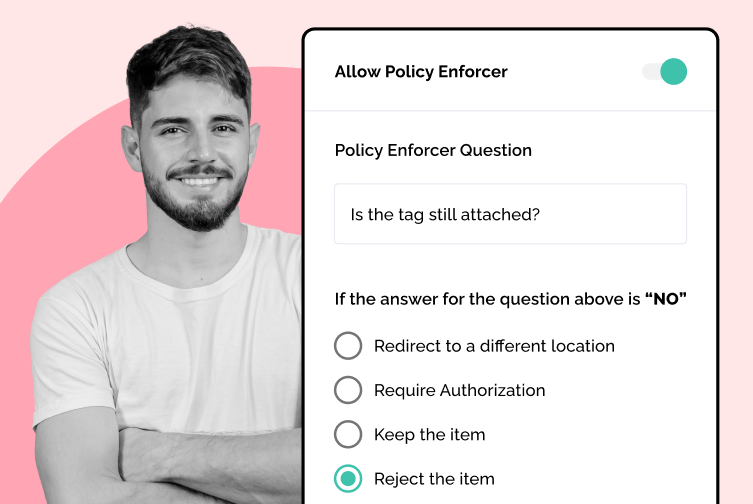
How to Prevent Wardrobing and Tag-Switching in Fashion Ecommerce
Learn effective strategies to combat wardrobing and tag switching in fashion ecommerce. Protect your business and enhance customer trust. Read more now!
Boost customer experience and reduce support tickets
Realtime order and shipment tracking
Proactive order and shipping notifications
Predictive pre-purchase estimated delivery dates
Self-Serivce branded order tracking
Effortless experience delivered
Make returns profitable and delight customers
Flexibility to define any return destinations & conditions
Simplify returns for your customers and team
Incentivize exchanges over returns
Returns management made easy for your team
Understand why your customers are returning
Unify the online and the in-store experience
Hassle-free pickup experience for customers
In-Store Dashboard to keep operations streamlined
In-Store and Online orders unified
Drive foot-traffic to your stores
Boost customer experience and reduce support tickets
Realtime order and shipment tracking
Proactive order and shipping notifications
AI-Enhanced Discounted Labels
Predictive pre-purchase estimated delivery dates
Self-Serivce branded order tracking
Effortless experience delivered
Make returns profitable and delight customers
Flexibility to define any return destinations & conditions
Simplify returns for your customers and team
Incentivize exchanges over returns
Returns management made easy for your team
Equip your team for precise return checks.
Understand why your customers are returning
Unify the online and the in-store experience
Hassle-free pickup experience for customers
In-Store Dashboard to keep operations streamlined
In-Store and Online orders unified
Drive foot-traffic to your stores
Find the answer to all your questions
Explore the most comon questions about WeSupply
Calculate the ROI that WeSupply can bring you
Request a no strings attached review of your current shopping experience and missed conversion opportunities
Take a step by step trip through our functionality to see how we can improve your ecommerce processes.
Read actionable articles on how to optimize your post-purchase experience and decrease support tickets
Get inspired by stories of how our customers implemented an effortless post-purchase experience
A Deep Dive into Top Companies' Order Tracking & Returns Strategy
Wondering if WeSupply is a good fit for you? Read through our use cases to see how we can help you increase conversion & improve CX!

In eCommerce and retail, the sale doesn’t mark the end of the customer journey it’s just the beginning of a deeper relationship. What happens after a purchase can make or break customer loyalty, and post-purchase feedback is one of the most powerful tools you have for improving products, refining the customer experience, and driving growth.
A key metric for measuring customer loyalty and satisfaction in post-purchase feedback analysis is the net promoter score (NPS), which asks customers how likely they are to recommend your brand or product.
When gathered and acted upon effectively, post-purchase feedback goes beyond compliments and complaints. Understanding customer feedback is crucial to identify gaps between customer expectations and their actual experiences. It becomes a roadmap for product innovation, a pulse check on customer satisfaction, and a fuel source for brand loyalty. This guide will explore how to capture, analyze, and transform feedback into tangible product and experience improvements, showing how post-purchase feedback analysis also measures customer loyalty and helps businesses track improvements over time.
Customer feedback after a purchase is like a behind-the-scenes tour of your business customers tell you exactly what’s working and what’s not. Satisfied customers are more likely to provide positive feedback and become brand advocates, helping to strengthen your reputation and attract new buyers.
After buying and using your product, customers have fresh, real-world insights that can inform improvements in design, quality, functionality, packaging, usability, or even your after-sales service. Unlike pre-purchase surveys, post-purchase feedback reflects actual experiences, making it more reliable for decision-making.
By listening closely, you can:
Identify product flaws before they become widespread issues.
Spot enhancement opportunities to better meet customer needs.
Boost retention by showing customers you value and act on their opinions.
Differentiate your brand through continuous, customer-driven innovation.
Leverage positive feedback to build trust and enhance your business reputation.
Post-purchase feedback provides valuable feedback that can be used to improve your products and services.
Businesses that treat feedback as an ongoing conversation not a one-off survey often see higher customer lifetime value and more positive word-of-mouth referrals. Additionally, you can gain insights from post-purchase feedback to inform strategic decisions and drive continuous improvement.
The first step is getting feedback into your hands, and that means using multiple channels to meet customers where they are most comfortable sharing their thoughts. To collect customer feedback effectively, it’s important to leverage a variety of channels such as surveys, chat, email, and social media.
When combining direct and indirect methods, businesses can gather feedback from sources like online reviews, social media comments, and direct customer interactions to get a comprehensive view of customer sentiment.
Businesses should gather customer feedback through both traditional methods like phone calls and in-person conversations, as well as digital means such as online surveys and email.
Using customer feedback surveys is especially beneficial for capturing immediate post-purchase reactions, providing valuable insights into customer satisfaction and purchase behavior.
These can be sent via email, embedded on thank-you pages, or triggered in your app. Crafting effective post purchase survey questions is crucial for gathering actionable insights that help improve customer experience and strengthen relationships. Tools like Qualaroo, Typeform, or Google Forms make it easy to design a simple post purchase survey, which increases completion rates and provides quick feedback. The key is to keep them concise ideally 3–5 questions and to include closed-ended questions that generate quantitative data for easy analysis.
A friendly follow-up email a few days or weeks after delivery can prompt customers to share how the product is working out. Timely post purchase communication via email not only improves customer satisfaction but also encourages valuable feedback. Personalizing the message (“Hi Sarah, how’s your new espresso machine?”) increases response rates.
Not all feedback arrives in your inbox. Customers often post honest opinions on Instagram, TikTok, Twitter/X, or Reddit. Social listening tools like Hootsuite or Sprout Social can help you spot trends and recurring issues. Monitoring and addressing negative reviews on these platforms is crucial to protect your brand reputation and build customer trust.
Your support team is a goldmine of feedback. Every ticket, chat transcript, or call log contains customer pain points that can reveal product or packaging flaws. Live chat and support logs are also powerful tools for increasing customer engagement, allowing you to interact with customers in real time and gather immediate feedback.
By combining direct requests (surveys, emails) and indirect listening (social media, support logs), you get a fuller picture of customer sentiment.
Collecting feedback is only half the job the real magic happens during analysis. To truly improve your products or services, it is essential to systematically analyze feedback from various sources to identify actionable improvements.
By leveraging modern tools and AI-powered solutions, businesses can now analyze customer feedback more efficiently, turning insights into concrete actions that drive growth and customer satisfaction.
Break down comments into clear categories:
Product Quality (e.g., durability, materials, performance)
Functionality & Features (e.g., missing functions, usability)
Packaging & Delivery (e.g., damage, presentation, eco-friendliness)
Customer Support Experience (e.g., responsiveness, helpfulness)
Categorizing customer data in this way helps identify trends and prioritize improvements based on actionable insights.
This makes it easier to spot patterns and prioritize fixes.
Not all feedback is equal. Use a priority matrix:
High Impact / High Frequency → Address immediately.
High Impact / Low Frequency → Monitor, then fix if necessary.
Low Impact / High Frequency → Improve if low effort.
Low Impact / Low Frequency → Lower priority.
Focusing on valuable customer feedback ensures your resources are allocated to the most impactful changes, maximizing improvements to your products and services.
Manually reading every comment can work for small volumes, but AI-powered tools like MonkeyLearn, Medallia, or Qualtrics XM can process thousands of data points quickly, detecting sentiment, urgency, and recurring themes.
The end goal is turning raw text into actionable insights so you can confidently decide which improvements to make first.
Post-purchase feedback is a direct window into customer satisfaction, one of the most critical success metrics for any business. Acting on this feedback can improve customer satisfaction and lead to long-term loyalty.
When customers feel heard and see changes based on their suggestions their trust deepens. For example, if several customers mention your clothing line’s zippers breaking after two washes, proactively improving zipper quality can lead to glowing reviews and repeat orders.
To boost satisfaction using feedback:
Identify recurring product frustrations and fix them promptly.
Enhance packaging if customers report damage during shipping.
Upgrade features customers request most often.
Improve instructions if customers struggle to set up or use your product.
Address feedback to increase customer satisfaction and encourage repeat buyers.
The key is to treat each suggestion as a loyalty investment, not just a complaint. Using feedback to make improvements can also boost customer loyalty.
Your CRM system can play a central role in managing post-purchase feedback and acting on it. By integrating feedback into your CRM, you can improve customer retention through personalized follow-ups and targeted offers that address specific customer needs and preferences.
Once feedback is stored in your CRM, you can automate personalized thank-you messages, updates on product fixes, or exclusive offers for returning customers who helped shape the product. Personalized follow-ups can also address the unique needs of individual customers, improving their experience and fostering stronger relationships.
If feedback reveals that certain customers love a specific feature, you can send them early-bird invites for related product launches. Analyzing feedback also helps identify customer preferences, allowing you to tailor your marketing campaigns for greater effectiveness.
Over time, your CRM creates a feedback history for each customer, letting you see if past issues were resolved and whether satisfaction improved. Tracking these interactions also helps businesses adapt to customers’ preferences, ensuring communication and service align with what customers value most.
When integrated properly, feedback stops being a random file on your desktop and becomes a strategic tool woven into your customer relationship strategy.
An effective post-purchase survey is short, engaging, and laser-focused on actionable insights. Customer satisfaction surveys are a valuable tool for gathering feedback after a purchase, helping businesses evaluate the customer experience and identify areas for improvement.
Keep it under 5 questions.
Use a mix of rating scales and open-ended questions.
Offer incentives to boost response rates (discount codes, small freebies).
Send surveys while the purchase is still fresh in the customer’s mind.
Implement post purchase surveys to gather timely and relevant feedback that can help improve your products and services.
Surveys should not just be a “check-the-box” activity they should be carefully crafted to uncover product strengths and weaknesses.
To get the most from post-purchase feedback, you need a repeatable, structured process that your team follows every time.
Collect feedback via multiple channels.
Analyze using categorization, prioritization, and AI tools.
Share insights with product, marketing, and operations teams.
Act on the highest-priority issues.
Close the loop with customers by telling them what you changed.
For example, a skincare brand might discover through feedback that customers dislike a pump dispenser. The brand could redesign it, inform customers of the update, and see both satisfaction and sales improve.
This process ensures feedback doesn’t die in an email inbox but instead drives continuous improvement.
Post-purchase behavior such as whether customers return products, recommend them to friends, or leave reviews is deeply influenced by how well their expectations were met. Analyzing feedback not only helps you improve post purchase behavior but also encourages positive post purchase behavior, leading to greater customer satisfaction and loyalty.
By combining feedback analysis with behavior tracking, you can discover patterns like:
Customers who complain about confusing instructions are less likely to repurchase.
Buyers who praise packaging aesthetics are more likely to post unboxing videos online.
Satisfied customers are more likely to make repeat purchases and become loyal customers.
Pairing survey results with behavioral data helps you pinpoint exactly which changes will have the biggest business impact.
Understanding overall satisfaction is essential for seeing the big picture of your customers’ experience after a purchase. By implementing post-purchase surveys, you can gather comprehensive feedback that reveals how customers feel about their entire journey from the moment they placed an order to the moment they used your product. These surveys are a powerful tool for analyzing customer feedback, as they allow you to identify trends and patterns in customer expectations and preferences.
Asking customers to rate their overall satisfaction with their purchase provides valuable insights that go beyond individual product features or isolated incidents. This holistic view helps you pinpoint what’s working well and where there’s room for improvement. By consistently collecting and analyzing this comprehensive feedback, you can make data-driven decisions that enhance customer satisfaction and create a more positive post-purchase experience. Ultimately, understanding how customers feel about their overall experience enables you to deliver on their expectations and build lasting loyalty.
Returns Analytics for eCommerce Business
Book a quick call with our experts to see how WeSupply can help you understand why your customers are returning: Identify the most returned products, Understand why those products are returned, Identify which customers are serial returners, Reduce Return Rate with Actionable Insights, Returns data available in BigQuery.
Now comes the most important step translating feedback into real, measurable product changes. Conducting a thorough post purchase evaluation is crucial, as it helps identify specific areas where your product can be improved based on actual customer experiences.
Tech Products → Add a longer charging cable if customers say it’s too short.
Home Goods → Use sturdier materials if customers report breakage.
Apparel → Adjust sizing charts if customers complain about inconsistent fit.
Food & Beverage → Modify packaging to keep products fresher longer.
The critical factor is closing the loop: let customers know their feedback directly shaped the change. This transparency turns customers into brand advocates.
Taking action on customer feedback is where real transformation happens in the post-purchase process. When you leverage customer feedback from post-purchase surveys, you gain the insights needed to make meaningful improvements to both your products and the overall customer experience. For example, if survey responses highlight frustration with the purchasing process, you can streamline checkout steps or clarify communication to make the process smoother and more efficient.
Similarly, feedback about product quality can guide you in refining materials, design, or functionality to better meet customer needs. By actively implementing changes based on what customers share, you show that their voices matter boosting customer satisfaction and building trust. This commitment to continuous improvement not only enhances the post-purchase experience but also increases customer loyalty, as customers are more likely to return and recommend your brand when they see their feedback leads to real results.
Once you’ve made changes based on customer feedback, it’s crucial to measure their impact to ensure you’re meeting customer expectations and driving real improvements. Conducting follow-up post-purchase surveys allows you to gather fresh customer feedback and analyze survey responses to see if satisfaction levels have increased. By comparing feedback before and after implementing changes, you can identify which adjustments have been successful and where further refinement is needed.
This ongoing process of analyzing customer feedback helps you fine-tune your products and purchasing process, ensuring that you’re always aligned with what your customers want. Additionally, tracking these improvements within your customer relationship management system provides a clear record of progress and helps you tailor future interactions. Measuring the success of product improvements not only boosts customer satisfaction but also strengthens your overall customer relationship management strategy, leading to higher loyalty and repeat business.
While leveraging customer feedback is essential for business growth, implementing feedback isn’t always straightforward. One common challenge is sifting through large volumes of feedback data to extract actionable insights. With so many survey responses and comments, it can be difficult to prioritize which changes will have the greatest impact on customer satisfaction and loyalty.
Another hurdle is distributing post-purchase surveys effectively—reaching the right customers at the right time to gather meaningful feedback. Negative feedback can also be tough to handle, as it requires thoughtful analysis and a proactive approach to turn criticism into improvement opportunities. Tools like sentiment analysis and survey data analytics can help you make sense of feedback and identify key areas for action.
By addressing these challenges head-on and leveraging customer feedback strategically, you can enhance customer satisfaction, increase customer loyalty, and drive sustained business growth. The key is to view every piece of feedback as a chance to learn, improve, and strengthen your relationship with your customers.
In eCommerce, post-purchase feedback isn’t just “nice to have” it’s a goldmine for improving products, enhancing customer experiences, and reducing costly returns. WeSupply transforms raw customer comments, return data, and review insights into actionable strategies that boost retention, revenue, and satisfaction.
With WeSupply, you can:
Get SKU-Level Insights: See detailed product and variant data from size and fit to color and quality so you can adjust product pages, sizing charts, and images with confidence.
Track CSAT, NPS & CES: Measure customer sentiment in real time to understand what’s working and address issues before they harm loyalty.
Monitor Order Flow Analytics: Access end-to-end visibility over order statuses, delivery exceptions, and processing times, enabling proactive customer communication.
Understand Financial Impact: Quantify the true cost of returns and exchanges to inform smarter pricing, product, and policy decisions.
Leverage Review Integrations: Connect with leading platforms like Loox, Judge.me, Yotpo, Stamped, and more to capture, analyze, and display authentic customer feedback.
Access BigQuery Analytics: Dive deep into returns, orders, and feedback data for precise, data-driven improvements across your operations.
By combining customer feedback analysis with advanced returns and order analytics, WeSupply helps you not only solve problems but also uncover opportunities turning every post-purchase touchpoint into a chance to delight customers and grow your business. See WeSupply in action book your free demo today and turn feedback into growth!
Post-purchase feedback isn’t just a courtesy it’s a powerful driver of growth. With WeSupply, you can pinpoint return triggers, gain SKU-level insights on fit, color, and quality, and track CSAT, NPS, and CES to understand customer sentiment in real time.
Our order flow analytics reveal processing times, delivery exceptions, and shipment statuses, while BigQuery integration unlocks deep, data-driven insights. You can quantify the financial impact of returns, optimize products and policies, and capture authentic reviews through integrations with Loox, Judge.me, Yotpo, Stamped, and more. By treating feedback as a continuous improvement cycle, you transform customers into co-creators of your brand.
The result? Higher retention, stronger relationships, and customers who buy more often and share their positive experiences turning every post-purchase touchpoint into an opportunity for lasting loyalty.
Combat inconvenience with proactivity & self service
Book a quick call with our experts to see how WeSupply can help you make returns easy for your customers with a beautiful, self-service solution that makes their experience easier while also providing new ways to lower costs and earn back revenue.
1. What is post-purchase feedback in eCommerce?
Post-purchase feedback is customer input shared after buying a product, offering insights on quality, usability, delivery, and service to improve products and enhance customer experience.
2. Why is post-purchase feedback important?
It reveals real customer experiences, helping businesses fix issues, enhance satisfaction, and boost loyalty through continuous improvement.
3. How can businesses collect post-purchase feedback?
Use surveys, follow-up emails, social media monitoring, live chat, and customer support logs to capture fresh, actionable insights.
4. How does WeSupply analyze post-purchase feedback?
WeSupply transforms customer comments, reviews, and return data into actionable insights using SKU-level analytics, sentiment tracking, and integrated review platforms.
5. Can WeSupply track return triggers and product issues?
Yes. WeSupply identifies frequently returned items, common reasons, and quality or sizing problems to prevent avoidable returns.
6. Does WeSupply integrate with review platforms?
WeSupply connects with Loox, Judge.me, Yotpo, Stamped, and others to collect, analyze, and display authentic customer reviews.
7. Does WeSupply have an Official Shopify App?
Yes. WeSupply has an Official Shopify App. You can download it and start integrating with your Shopify Store.
8. Does WeSupply have an official Magento extension?
Yes, WeSupply has an official extension for Magento. The WeSupply x Magento integration allows for automating order tracking experiences, reducing customer inquiries, automating shipping email and SMS notifications, and providing a fully branded order tracking experience.
9. Does WeSupply have an official BigCommerce App?
Yes, WeSupply has an official BigCommerce App. You can integrate WeSupply with your BigCommerce store to improve your post-purchase customer experience.
Learn How To Create Successful Post Purchase Email Campaigns
Build an effective post-purchase email flow that helps you increase customer satisfaction and drive revenue growth!

Learn effective strategies to combat wardrobing and tag switching in fashion ecommerce. Protect your business and enhance customer trust. Read more now!
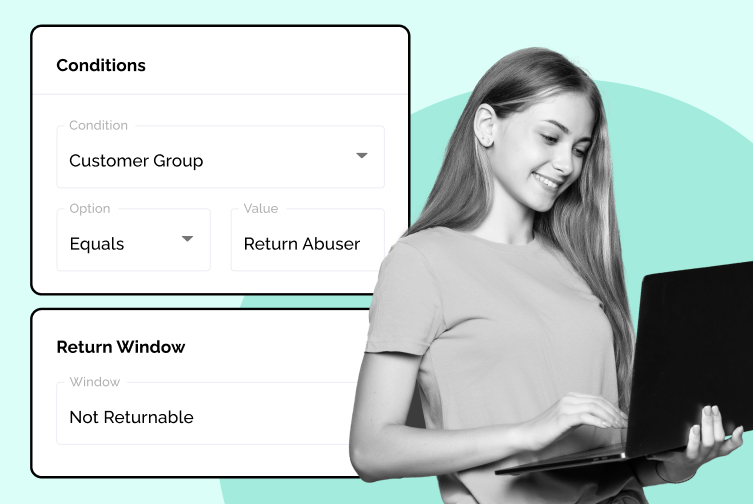
Learn how to manage BOGO returns effectively while ensuring customers aren’t charged for the free item. Practical solutions!
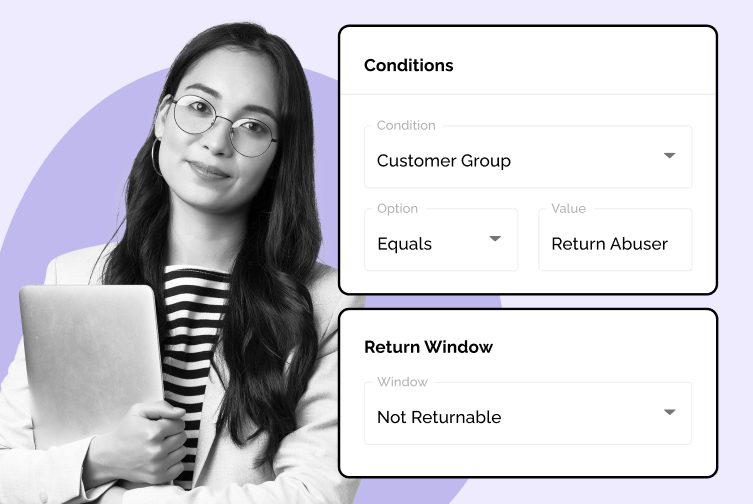
Explore how automation and data can enhance your shipping strategy. Discover best practices to stay competitive and efficient. Read the article now!

Discover effective strategies to prevent return promo abuse with smart logic. Enhance your business’s integrity!
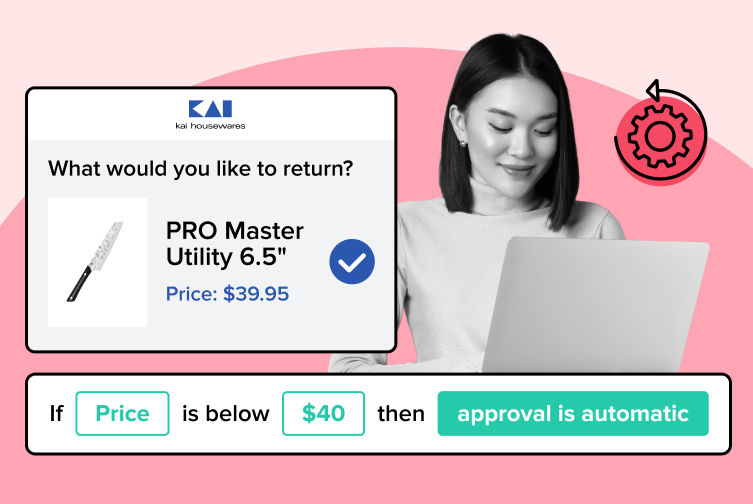
Learn how to effectively manage promo bundle returns while protecting your revenue. Discover practical tips to streamline your process!

Learn how to manage BOGO returns effectively while ensuring customers aren’t charged for the free item. Practical solutions!
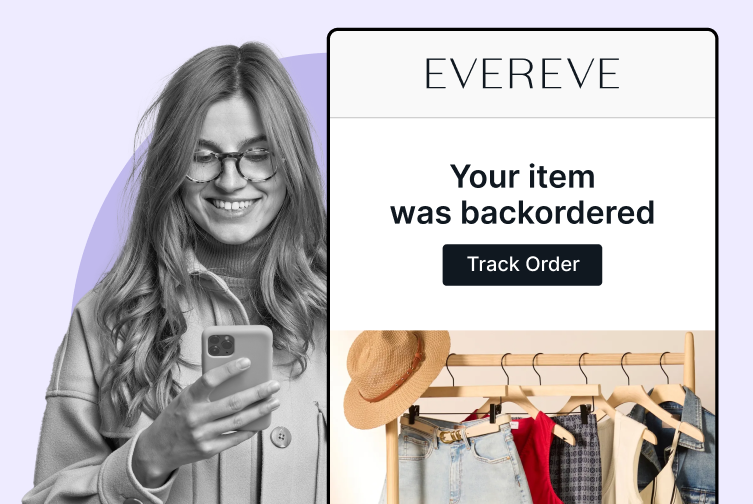
Explore how automation and data can enhance your shipping strategy. Discover best practices to stay competitive and efficient. Read the article now!

Discover effective strategies to prevent return promo abuse with smart logic. Enhance your business’s integrity!

Learn how to effectively manage promo bundle returns while protecting your revenue. Discover practical tips to streamline your process!